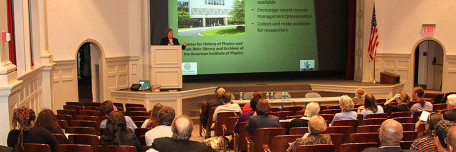The Lemon Project Committee on Memorialization held a community forum Wednesday, April 20 at the Stryker Center in Williamsburg. This forum, in conjunction with the one held April 11 at the Great Hall of the Sir Christopher Wren Building, was intended to gather ideas from the community regarding the proposal that the committee will submit to College of William and Mary President Taylor Reveley and Provost Michael Halleran later this year.
The LPCOM mission statement is to further the work of representation initiated by the Lemon Project through the establishment of a memorial to the enslaved and free blacks whose labor and lives the College exploited prior to the Civil War.
The committee has resolved that the historic campus is the appropriate location for the memorial. A national competition will be held to find a fitting design.
Slavery is by no means unique to the history of the College; many colleges and universities have had to confront the legacy slavery has left on their institutions and have memorialized this part of their history. LPCOM member Edith Heard said that it is important to recognize this history.
“We wouldn’t be the first nor the second, but we have to do something because of the history that’s in Williamsburg,” Heard said. “Tell it all — good, bad, ugly — just tell it.”
We wouldn’t be the first nor the second, but we have to do something because of the history that’s in Williamsburg,” Heard said.
Heard also used the forum as an opportunity to circulate a petition to rename Rawls Byrd Elementary School. The school is named after former Superintendent of Williamsburg-James City County Schools Rawls Byrd, who resisted integration and was known to act in a discriminatory way toward black students.
According to history professor Jody Allen, who co-taught the class “Memorialization of the Enslaved at William and Mary” from which the LPCOM originated, the LPCOM has seen great support from the College administration and nothing but positive responses from the community
LPCOM member Bronte de Cardenas ’16 said one of the reasons a memorial is so important is that the College still has a long way to go in terms of awareness on this issue.
“I think there are still a lot of people … who don’t know the history of the College, and don’t know who Lemon was, don’t know about this project,” de Cardenas said. “I know a lot of people who were very surprised to hear that the College owned slaves, so that’s something that’s not always talked about.”
De Cardenas said that it is important to acknowledge history even when it is painful.
“I think not talking about it is ignoring an entire part of our history, and I think it’s a false representation of who we are,” de Cardenas said.
I think not talking about it is ignoring an entire part of our history, and I think it’s a false representation of who we are,” de Cardenas said.
Sam Biddle, a former student in attendance, said he has seen an increase in awareness at the College about this issue
“I think that institutionally it’s growing in awareness; it’s growing in terms of coverage,” Biddle said. “I think there’s certainly more that needs to be done, but that’s not just the College’s responsibility but our society’s.”
One of the main issues addressed at the forum was whether the memorial should occupy an indoor or outdoor space. Several people in attendance voiced concerns that placing the memorial inside would make it less visible and less accessible. A consensus was reached that the location should be easily visible and accessible to both the College community and to the Williamsburg community.
Another common suggestion was that the memorial should encourage reflection and possibly even include a place to sit. However, other attendees said that while it is important that the memorial allow for reflection, it should also be disruptive and jarring, so as to not be easily ignored by passersby.
An issue in designing a memorial comes from the limited historical record of slave labor at the College. While research has brought to light documentation of slavery at the College, a knowledge gap still exists, making it difficult to recognize those enslaved people whose names have not survived.
To conclude the forum, de Cardenas asked those in attendance to discuss what they would want people 50 years from now to think about the memorial. One attendee said that he hoped the memorial would not put this matter to bed, but would rather act as an indication that racial justice is still a priority to the College community in addition to being a reminder of past injustices. Founding a research institute on racial and ethnic studies could be another way to ensure the legacy of the Lemon Project extends past the year 2018, when it is set to end.
“Talking about having a physical memorial doesn’t preclude any talk of having scholarships or any kind of continuing, less physical manifestation of a memorial to the enslaved at William and Mary,” de Cardenas said.

